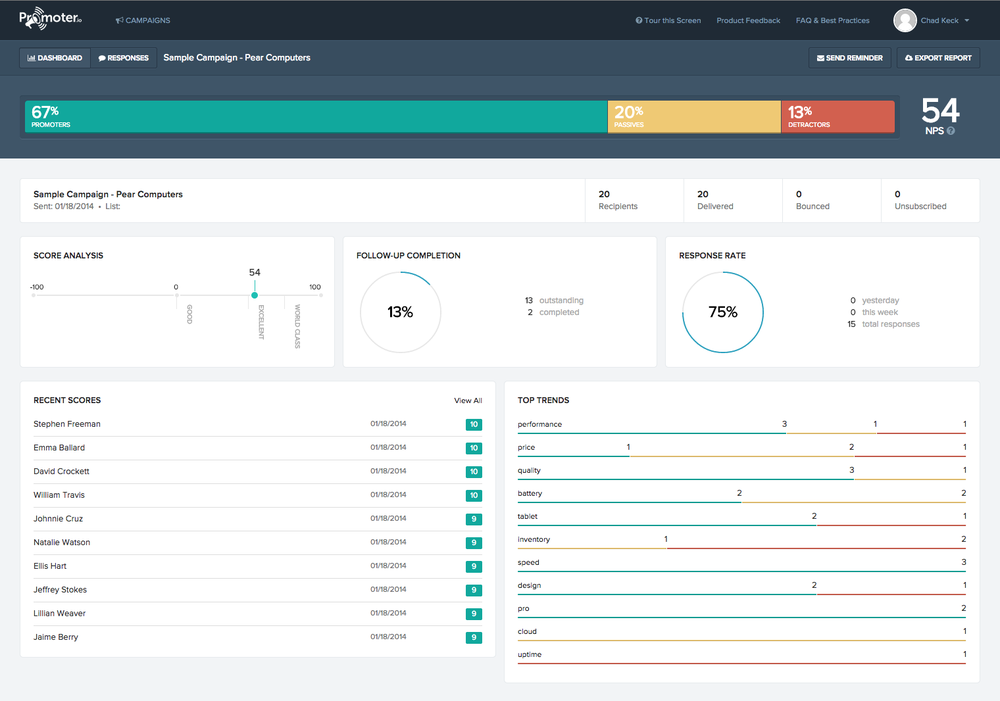Chartio's Net Promoter Score Best Practices
Posted by on April 7, 2015 Data, Data Analytics
This is followup to our post on Get More Out of Your Net Promoter Score by Linking Customer Behavior.
What’s the best way to measure how happy your customers are?
As we started to think about that question, we investigated what other companies are doing. After some investigation, we settled on using a Net Promoter Score to measure customer satisfaction. This is a common methodology that has some big advantages: it’s well understood, useful for benchmarking because it’s commonly used, easy to administer, simple to read, and so easy for your customers that you’ll get a high response rate.
A classic NPS survey asks two simple questions: “How likely are you to recommend our company to a friend or colleague on a scale of 0 to 10?”, followed by an open-ended question about why the respondent gave you that score.
Calculate your Net Promoter Score by taking the percentage of customers who gave you a 9 or 10 (Promoters) and subtracting the percentage who gave you a 0 to 6 (Detractors). So, if 50% of your customers gave you a 9 or 10, and 27% gave you a 6 or below, your NPS is 23.
NPS is a single index of customer happiness that is not only easy to trend, but also easy to tie to your customer information.
Surveying Our Customers
We followed the usual NPS practice of surveying a third of our users each month, so that each user gets surveyed once per quarter. I pulled a list of email addresses using Chartio using the remainder of their user ID when divided by three. This divided the user list into thirds in a way that was easily trackable and constant over time.
To survey our users, we used Promoter.io which makes it easy to send a NPS survey to your customers and to review the results. SurveyMonkey also has a set of easy to use NPS templates. Or you could use an on-site survey tool, such as Qualaroo. Promoter.io makes it easy to tag your open-ended responses for deeper analysis and provides a terrific-looking dashboard for reviewing your results.

Promoter.io’s dashboard does a great job of showing you the current state of each NPS survey.
Promoter.io also makes it easy to follow up with users who gave us a low score (yes, there were a few of those) and see what we could do to improve their satisfaction with Chartio. We’re convinced that this process will not only help us track our user satisfaction, but actively improve satisfaction and reduce churn.
Not Everyone Likes NPS
Supporters of NPS will often claim that there is a strong connection between NPS and company growth. Although we’re skeptical of that bold claim, it worked for us as a simple index of customer satisfaction, and we’re also not convinced that it has any of the mystical properties that some consultants attribute to it.
The calculation of the NPS also involves some assumptions about, say, the difference between a willingness to recommend and passivity, which may not be correct.
NPS Best Practices & Recommendations
Make sure you’re able to integrate your NPS data with your user data. We were able to use email addresses to link user satisfaction responses to our users’ accounts and their behavior in our system.
Respond to unhappy - and happy - customers. We made a point of responding to every customer who took the time to respond to our survey. Either addressing any issues they had, passing on their suggestions to our engineering team, and simply thanking them for letting us know what they think.
Keep your methodology simple and repeatable. We chose Promoter.io because they made it simple to survey a third of our customers each month, follow up with a second survey for non-responders, keep our surveys consistent, and track our responses as they came in.
Don’t expect to find useful benchmarks for free. Individual companies closely guard their NPS scores, so the only companies with useful benchmark data for a particular industry (say, enterprise SaaS companies) are unlikely to share that information without charging a lot for it.


